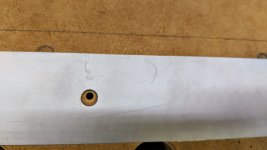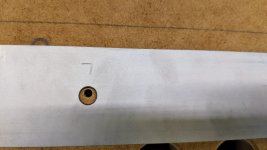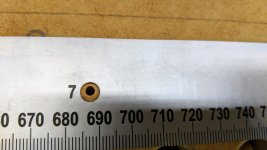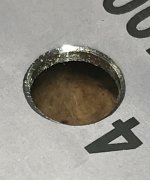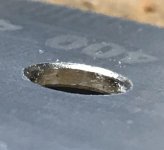Richard/RMW
Member
- Joined
- Jul 11, 2010
- Messages
- 2,947
Solly1 said:Solly1 said:I have found that both of my Parf sticks appear to be identical, with what appears to be machined rather than punched holes, and with the threaded pin in hole zero I can drop the longer drill guide into any hole with absolute ease, the scales on each rule also align perfectly. Fingerprints along both rules, fractionally raised painted lettering on both.
[member=4518]Mike Goetzke[/member], [member=67413]box185[/member], [member=8389]gnlman[/member]
So it seems whist my previous observations holds true, I haven't avoided issues that prevent using the system ... I'll try my best to explain. Let me know if you see a better test method.
1) The rudimentary test of threaded pin in one end, double depth drill guide in any of the other holes, only seems to alerts you to any longitudinal discrepancy. With threaded pin in 0, and double depth drill guide in 10, clamped down - awl in 10 then drill guide tested in holes 5-9 reveal some lateral discrepancy on my pair of sticks. With some coaxing I can register the guide, but this results in some lateral deflection of the ruler. Your rules could marry, but this only proves they match, not that they are true.
2) There seems to be maybe 1 to 1.5mm flex possible in the middle of the rules with hole 0 and 10 pinned. Perhaps working inwards from the ends and registering pins (although only 3 provided) either side of the hole to be drilled would minimise the chance that you flex the rule while applying downward but perhaps slightly lateral pressure on the drill guide whilst drilling.
3) With a test set of a single row of 10 holes, and UJK dogs in holes 0 and 10, a third dog in any of the holes 2-9, results in a Veritas straight edge rocking to varying degrees around the middle dog pivot point, worsening at 0 as you move the central dog closer to 10. With a dog in 9 and 10 anchored, and the straight edge pulled tight to these dogs, the discrepancy at hole 0 is approx 2mm (8=1.75mm, 7=1.25mm, 6=1.1mm, 5=0.75mm, 4=0.6mm, 3=0.25mm, 2=0.1mm). At 1 and 10 it's negligible at 0. It therefore appears I have a "bow" in rule #1 from holes 2 to 10.
Same process with ruler #2, the discrepancies are in the same direction, but inaccuracy approx halved. See Point 1.
4) I understand that the edges of the rules are not to be used for any form of reference, but the "bow" explained above is also mirrored with the top or bottom edges of the rule up against the straight edge, and magnified if the rule is flipped over. It can also be exhibited by applying the straight edge to the pins inserted in the rule. Both my pins (within 0.04mm) and rules (within 0.1mm) appear to be relatively consistent widths according to my mediocre calipers for this test to hold some merit - the rule edges may bear no reference to the holes, but I would presume they are intended to be machined somewhat straight and parallel.
5) It's possible these discrepancies could be compounded, depending on which way you position your rules to do rows and columns, and magnified further over longer runs than 1000mm highlights (in my case more than doubled over 2400mm).
About to contact the local supplier in Oz (Carbatec, hopefully as helpful as Axminster) and pick up some more MDF stock to test the triangular impact of the discrepancies noted ...
Cheers
Solly
[member=70294]Solly1[/member] that's disappointing to hear. The entire concept of the system is based on the geometric perfection of the components, it's starting to sound like Axminster has an issue delivering consistency. I checked my new stick to make sure the holes lined up with each other from end to end but didn't check either centerline hole-to-hole nor that they were in alignment end to end.
I brought my original pair of sticks into my office/workroom in the house to use them as straightedges and when I just checked them that are not both totally straight over their length. I compared them against each other, alternately flipping the over front/back and above/below each other until a pattern established. One appears to be straight and the other bowed about .5mm in the center.
As long as the holes are in line the straightness of the stick itself shouldn't matter, within reason. I guess I'll have to check the new sticks before making a top.
Based on what little I really know about machining I believe it is challenging to get precision in the 1,000's of an " over a meter long stretch. I'd assume the only way to assure that accuracy is to physically inspect each stick prior to shipping. My hunch is there would be a lot of rejected sticks. Caveat being I have zero idea what is an acceptable tolerance nor what Axminster is aiming for.
RMW

